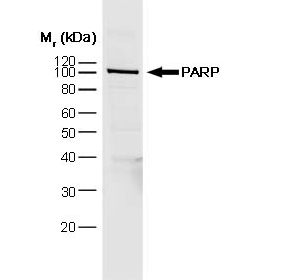PARP1 Mouse Monoclonal Antibody [Clone ID: A6.4.12]
Other products for "PARP1"
Specifications
| Product Data | |
| Clone Name | A6.4.12 |
| Applications | ELISA, IHC, IP, WB |
| Recommended Dilution | ELISA. Immunoprecipitation. Western Blot: 1/1000-1/5000. Immunohistochemistry on Frozen Sections. Immunohistochemistry on Paraffin Sections: This product requires antigen retrieval using heat treatment prior to staining of paraffin sections; Sodium citrate buffer pH 6.0 is recommended for this purpose. |
| Reactivities | Drosophila, Hamster, Human, Mouse, Rat, Xenopus |
| Host | Mouse |
| Isotype | IgG1 |
| Clonality | Monoclonal |
| Immunogen | Human PARP. Spleen cells from immunised BALB/c mice were fused with cells of mouse NSO myeloma cell line. |
| Specificity | This antibody recognises poly (ADP-ribose) polymerase (PARP). |
| Formulation | State: Aff - Purified State: Liquid purified IgG containing 0.09% Sodium Azide as preservative. |
| Concentration | lot specific |
| Purification | Affinity Chromatography on Protein G. |
| Conjugation | Unconjugated |
| Storage | Store the antibody undiluted at 2-8°C for one month or (in aliquots) at -20°C for longer. Avoid repeated freezing and thawing. |
| Stability | Shelf life: one year from despatch. |
| Gene Name | poly(ADP-ribose) polymerase 1 |
| Database Link | |
| Background | PARP (Poly (ADP-ribose) polymerase) is a 113 kDa nuclear protein which can exist as a homo- or hetero-dimer, and is strongly activated by DNA strand breaks. This protein acts as a molecular ''nick sensor'' and functions in base excision repair, poly(ADPribosyl)ation of acceptor proteins involved in chromatin architecture and DNA metabolism, and participates in protein modification to enhance or repress transcription. PARP also plays a role in other cellular processes, including cell proliferation and differentiation. PARP is ribosylated by PARP2, and during apoptosis, ICE family members, such as caspase 3 and 7, cleave PARP to yield an 85 kDa and a 25 kDa fragment. PARP cleavage is considered to be one of the classical characteristics of apoptosis. PARP interacts with proteins in the base excision repair complex containing at least XRCC1, PARP2, POLB and LIG3. In addition PARP forms heterodimers with PARP2, and interacts with PARP3. |
| Synonyms | PARP-1, ADPRT, ADPRT 1, PPOL |
| Reference Data | |
Documents
| Product Manuals |
| FAQs |
| SDS |
{0} Product Review(s)
0 Product Review(s)
Submit review
Be the first one to submit a review
Product Citations
*Delivery time may vary from web posted schedule. Occasional delays may occur due to unforeseen
complexities in the preparation of your product. International customers may expect an additional 1-2 weeks
in shipping.






























































































































































































































































 Germany
Germany
 Japan
Japan
 United Kingdom
United Kingdom
 China
China



